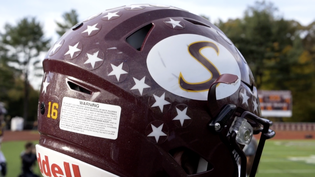|
By: Gil Owren, SHS Class of 1958  Playing football for the Summit Hilltoppers under Coach Howie Anderson was one of my highlights while growing up in Summit during the 1950s. The experience taught me important life skills, including the value of teamwork, the importance of discipline, the advantage of proper conditioning, how to make decisions under pressure, displaying good sportsmanship, and testing my courage when faced with stiff competition during games. Sixty years later, the current safety concern about the effects of playing football in the NFL is reaching the high school and youth tackle programs across the country. While the long-term safety concerns may be legitimate at the NFL level, there is a sharp distinction between playing in the NFL and playing football at the youth and high school levels. In researching this topic I found studies that support my opinion, including the results of two very recent studies.  In January 2017 the Mayo Clinic, a world-class team of over 330,000 doctors, scientists and researchers, published the results of a study, High School Football and Late-Life Risk af Neurodegenerotive Syndromes, 1956-1970. This Study was conducted to assess whether athletes who played varsity football between 1956-1970 at the public high school in Rochester, Minnesota have an increased risk of neurodegenerative diseases later in life. The study identified 296 varsity football players and 190 athletes who played other varsity sports. The Mayo Clinic concluded, "Compared with nonfootball athletes, football players did not have an increased risk of neurogenerative diseases overall or of the individual conditions of dementia, parkinsonism, and amyotrophic internal sclerosis." In July 2017 American Medical Association published the results of a similar study, Association of Playing High School Football With Cognition ond Mental Health Later in Life. Using data from a Wisconsin Study of men who played high school football and graduated in 1957, the AMA reported " ... there was no statistically or clinically harmful association between playing football in high school and increased cognitive impairment or depression later in life." Over the last 50 years, I have had the privilege and pleasure of coaching Summit football at every level. Rest assured that playing football in Summit is safer today than it has ever been. Consider the following safety precautions:
1. Every player must pass a physical examination conducted by his own doctor prior to participating. 2. All Summit Youth Football coaches must complete a course, Youth Tackle Football, and receive certification from USA Football before coaching. All Summit High School coaches must have a teaching certificate and successfully complete numerous courses related to football player safety. 3. Recent N.J. Laws passed by the state legislature to implement more stringent safety standards, especially relating to concussion protocol. 4. Each year High School Football Rules are reviewed and updated to better address player safety. 5. Several years ago, the Summit Board of Education adopted a policy for the prevention and treatment of injuries, including a detailed protocol relating to concussions. The Summit High football program has approximately 90 players grades from 9-12. During the 2016 season 3 players suffered concussions and 4 players experienced concussions during the 2017 season. These players followed the concussion protocol and returned to practice when they were cleared. It should be noted the number of concussions in football is similar to the number of concussions in other sports at Summit High School, including men's soccer and men's lacrosse. 6. Safety measures have increased for all levels of tackle football. At the youth level, Summit Youth Football has instituted flag football for grades K-5. Tackle football starts for grades 6-8. Summit Youth Football fields 3 teams (6, 7, & 8) in the Suburban Youth Football League, playing one game each week against teams from surrounding towns. The upcoming season marks Summit's 481h year of participation in League play. League rules restrict practice time and all coaches must be certified, as mentioned above. 7. At the high school level, practice time has been reduced and the amount of contact during practices has also been decreased to increase player safety. 8. Summit's Overlook Hospital is one of two hospitals in NJ that has a Center for Concussion Care. A certified trainer is assigned by the Center to attend every Summit Youth Football home game. A team doctor, familiar with concussion protocol, is at every high school game. A certified trainer is also at every high school game and available for every practice. It should be noted that Summit High School has two certified trainers who are full-time staff members. 9. Prior to the 2017 football season, the mothers of Summit's five captains helped raise $35,000.00 to purchase new, upgraded helmets for the 2017 season. They replaced helmets that were fully certified, but the new helmets were an improvement from standpoint of player safety. 10. For the 2018 season, Summit plans to purchase a protective cap that is worn over the helmet during practice for additional player safety. Enhanced safety equipment and measures require funding. The community of Summit, led by the Summit Board of Education, Summit's Department of Community Programs, parents, and the Summit Football Alumni Association, has always made sure that our young men have the safest possible environment to enjoy playing the game of football in Summit.
25 Comments
|
Archives
July 2018
Categories |

